

On November 12, 2023, a landslide and tunnel collapse trapped forty-one construction workers in a tunnel in the Himalayas in northern India. On November 28, after 17 days underground, all of the workers were freed! They emerged through a 3-foot-wide escape tunnel that rescuers had carefully drilled. Although wheeled stretchers were available, the men crawled out through the tunnel on their own.
Family members of the workers, many of whom had camped outside of the tunnel during the rescue effort, greeted them. Government officials placed flower garlands around their necks (a celebratory custom in India). Doctors and ambulances waited to take the men to a nearby hospital for a check-up. All the men appeared healthy.
Building the Char Dham Highway
The construction workers had been building the tunnel as part of the Char Dham Highway route. When the landslide occurred, nearly 200 feet of rubble covered the only entrance. According to experts, the tunnel did not have an emergency exit.
The Char Dham Highway is a multimillion-dollar project near the border with China. The project’s goal is to improve connectivity in the state of Uttarakhand, India.
The construction goes through a geological fault, and geologists believe continued drilling can cause more problems in an area that already commonly experiences landslides and earthquakes.
During the Rescue Efforts
Rescuers first inserted a 6-inch-wide pipe through the rubble to communicate with the trapped men. The rescuers also used the 173-foot (53-meter) pipe to deliver food, water, medicine, and oxygen to the workers. Family members spoke to the men through the pipe daily to help raise their spirits. While trapped in the tunnel space measuring about 1.2 miles (2 km), the men did yoga and played games of cricket to pass the time.
Problems Encountered
The rescue operation involved stages of various plans being worked on at the same time. In one plan, the team worked to drill an escape tunnel horizontally using large drills flown into the site. After the team drilled the hole, they inserted 3-foot-wide pipes and then welded the pipes together to form an escape passage. In a backup plan, rescuers drilled downward through the unstable mountain to create another escape route. Geologists warned that this drilling might cause more of the roof to cave in.
The team encountered several setbacks as they worked. The first large drill broke several times and needed to be replaced. Then rocks, stones, and twisted metal in the rubble broke a large drill blade. The broken drill blade stopped rescue efforts with only about 40 feet left to reach the trapped men.
A team of “rat hole miners” was then brought in from central India. These miners are experts in a highly dangerous technique of hand drilling narrow tunnels to mine coal. They get their name because they look like burrowing rats when digging. The rat hole miners successfully cleared the remaining debris in less than a day to reach the trapped workers.
India’s minister of road transport, Nitin Gadkari, said the government would investigate and do a safety review of the tunnel project.
